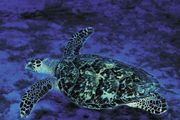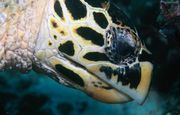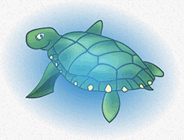Beaches Sea Turtle Patrol
- 14
- Jan
This information is brought to you by The Green Turtle Bay Vitamin Co.
No turtle products are used in our nutrients! www.EnergyWave.com
BEACHES SEA TURTLE PATROL
About Sea Turtles (click here for additional turtle resources)
Sea turtles have inhabited the oceans for over 100 million years. Today there are only seven species of this unique and endangered creature remaining in the world and five of these occur in our Atlantic Ocean. Over 80% of sea turtles nesting in the United States come to our Florida coast line. The species which nest most frequently in Florida is the Loggerhead turtle. The Green and Leatherback turtles are also occasionally sighted in these waters.
The adult turtles leave their natural habitat of the sea to nest on beaches during the summer months. From May through September they nest approximately three to five times, at two-week intervals. Under cover of darkness, the female drags her large body by her flippers toward an area above the high tide line. She then digs a hole with her rear flippers and deposits over 100 eggs. She covers the eggs with sand and returns to the ocean, never to know the fate of the hatchlings.
After an incubation period of fifty to sixty days, the young turtles break out of their shells and slowly work their way to the surface. After dark, they scramble out of the sand and head toward the brightest horizon, which under natural conditions, is the reflective light of the ocean. The hatchlings are exposed to many dangers. It is estimated that only one or two in 1,000 survive to adulthood.
Sea Turtle Conservation problems
 In the United States, a major threat to sea turtles lies in the continuing destruction of their nesting beaches. Vehicular traffic, loss of dune systems and beach front lighting also effectively reduce nesting success.
In the United States, a major threat to sea turtles lies in the continuing destruction of their nesting beaches. Vehicular traffic, loss of dune systems and beach front lighting also effectively reduce nesting success.
Beach front lighting often deter females from nesting, and in particular, disorients emerging hatchlings from their natural course to the sea. They wander toward the artificial lights and away from the water. They are then destroyed by predators, vehicles and dehydration. Litter on the beach can create further obstacles for the hatchlings.
The hatchlings have many predators, including dogs, ghost crabs and especially birds. During their scramble to the sea, these predators are responsible for the deaths of most of the hatchlings. Once in the sea, larger fish become their predators. Once the turtles reach adulthood, only a few enemies remain, namely sharks and man.
Current trends of ocean pollution and dumping create a major threat to survival of all ocean life. Many turtles die from eating plastics dumped in the ocean, which resemble the jellyfish some species love to eat. The plastics and other trash, once ingested, block the intestines and cause death by starvation.
The Beaches Sea Turtle Patrol, Inc. is always looking for volunteers:
beach walkers, joggers and bicyclists are always needed for the patrol. Their patrol covers Atlantic Beach, Neptune Beach, Jacksonville Beach, Abby Hanna Park and the U.S. Naval station, Mayport.
There was no beach re-nourishment in the 1996 season so all nests have been left in their original location. Each nest is marked with wood stakes and brightly colored tape so that people in the immediate area are able to avoid disturbing it. These nests are constantly monitored. Nests left in place tend to hatch earlier or later than expected due to the wind and wave action and subsequent shifting of the sand. Few humans are fortunate enough to actually witness hatchlings emerge from a nest and scamper across the moonlit beach and plunge into the water since the time involved is only a matter of minutes.
Unfortunately, strandings (dead or weakened sea turtles) occur all year throughout the area beaches. Unless there is a large red “X” painted on the sea turtle’s carapace (upper shell) the sea turtle patrol should be called at 904-241-7631. A red “X” means the turtle has already been examined and reported to the Department of Environmental Protection (DEP). If the turtle is alive do not attempt to put it back in the ocean. Try to keep it wet with a towel or shirt until the Florida Marine Patrol or someone from the Sea Turtle Patrol arrives.
The Beaches Sea Turtle Patrol, Inc.
(http://www.bstp.net/) Is a Florida non-profit corporation located at:
Sea Turtle information.
Beaches Sea Turtle Patrol, Inc.
(A Florida Non-Profit Corporation)
P. O. Box 50723
Jacksonville Beach, FL 32240-0723
Telephone: 904-613-6081/E-mail: info@bstp.net
More about Turtles…
Thousands of sea turtles call Florida home
 Sea turtles are large air-breathing reptiles remarkably adapted to life in the sea. They live in all but the coldest of the world’s oceans, but nest only on tropical and subtropical beaches where it is warm enough to incubate their eggs. All sea turtles are protected by federal and state laws. Of the eight species of sea turtles worldwide, five are found in Florida. Sea turtles deposit from 40,000 to 70,000 nests in Florida annually, which makes this the most important nesting area in the US. Sea turtles most commonly seen in Florida are loggerheads, greens, and leatherbacks.
Sea turtles are large air-breathing reptiles remarkably adapted to life in the sea. They live in all but the coldest of the world’s oceans, but nest only on tropical and subtropical beaches where it is warm enough to incubate their eggs. All sea turtles are protected by federal and state laws. Of the eight species of sea turtles worldwide, five are found in Florida. Sea turtles deposit from 40,000 to 70,000 nests in Florida annually, which makes this the most important nesting area in the US. Sea turtles most commonly seen in Florida are loggerheads, greens, and leatherbacks.
Adapted to a life at sea
Sea turtles have a low streamlined shell and powerful, oversized front limbs, adaptations that enable them to swim for great distances. They have no teeth but use their jaws to crush and tear food. The smallest sea turtle, the ridley, weighs about 75 to 100 pounds when mature while adults of the largest species, the leatherback, can weigh almost 1,300 pounds and may be eight feet in length.
Females nest on sandy beaches
Sea turtles spend most of their day feeding or sleeping under reef ledges or in the open ocean. Some travel hundred or thousands of miles to feed or nest. Females lay their eggs on sandy beaches and are slow and awkward on land. A female will usually lay several nest during one season and may nest every two to three years. The difficult process of nesting takes up to three hours. A turtle must drag her great weight ashore, dig a nest with her back flippers, deposit about one hundred eggs, and cover and conceal the nest before returning to the sea. The eggs incubate in the warm sand and the female never visits her nest again.
Hatchlings must fend for themselves
After incubating for about two months, the two-inch long turtles hatch, erupt as a group from their nest in the cool of the night, and scurry down the beach to the sea. Many hatchlings swim offshore to line for several years in floating seaweed drifting along the edges of ocean currents. Eventually the young turtles take up residence in coastal waters. Many years pass before the few hatchlings that survive reach maturity. A sea turtle may live for 40 to 60 years or more.
Few natural enemies but many man-made threats
Sea turtles once roamed the oceans by the millions, but over the past few centuries the demand for sea turtle meat, eggs, shell, leather and oil has greatly reduced their number. Populations continue to decline as habitat is lost and the trade in sea turtle products continues. Every year, thousands of sea turtles drown in shrimp trawls and other fishing gear and others die from pollutants or from swallowing trash mistaken for food. Many hatchling sea turtles are disoriented by bright lights near beaches and wander away from the ocean to be crushed by cars or stranded. Concern for the plight of sea turtles is growing and people around the world are working to protect them on nesting beaches and at sea.
How you can help
Never approach turtles emerging from the sea or disturb or harass nesting turtles. Watch nesting turtles by joining one of the many state-permitted turtle walks conducted by experience guides.
Watch out for disoriented hatchlings or turtles wandering on the road. If you’re near or on the beach, keep outside lights off or minimized from May 1 – October 31. Be careful while boating to avoid collisions with turtles and never throw trash in the water or on the beach.
Become informed about environmental issues and spread the word to others. Support conservation groups that are active in sea turtle issues such as the
- Center for Marine Conservation (http://www.mcbi.org)
1725 K St. NW, Suite 212
Washington, DC 20006, USA
Telephone: 202 887-4960 - Center for Marine Conservation: Southeast Atlantic and Gulf of Mexico Regional Office (http://www.cmc-ocean.org)
1 Beach Drive, SE, Suite 304
St. Petersburg, FL 33701
Telephone: 727 895-2188 - The Nature Conservancy, the Caribbean Conservation Corp (http://www.floridamarine.org/partners/)
Florida and Caribbean Marine Conservation Science Center at the University of Miami
PO Box 249118
Coral Gables, FL 33124
Telephone: 305 284-3013 - Caribbean Conservation/Sea Turtle Survival League (http://www.cccturtle.org)
- The Beaches Sea Turtle Patrol (http://www.bstp.net/)
P.O. Box 50723
Jacksonville Beach, FL 32240-0723
Telephone: (904) 613-6081
NEVER BUY PRODUCTS MADE FROM SEA TURTLES OR ANY OTHER ENDANGERED SPECIES.
SEA TURTLE FACTS
Hawksbill Turtle
The endangered hawksbill, a relatively small turtle, has been hunted to the brink of extinction for its beautiful shell. Once relatively common in Florida, these turtles now nest here only rarely. Hawksbills feed on sponges and other invertebrates and tend to nest on small, isolated beaches.
Kemp’s Ridley
The rarest and smallest of all the sea turtles, the endangered Kemp’s ridley feeds in the coastal waters of Florida on blue crabs and other crabs and shrimp. All Kemp’s ridleys nest on a single stretch of beach on the Gulf coast of Mexico.
Loggerhead Turtle
The loggerhead turtle is the most common sea turtle in Florida. It is listed as a threatened species under the federal Endangered Species Act. Named for its large head, which can be ten inches wide, it has powerful jaws to crush the heavy-shelled clams, crabs and encrusting animals on which it feeds. IN the past few years, 49,000 to 68,000 loggerhead nests have been recorded in Florida annually.
Green Turtle
The green turtle, named for the greenish color of its body fat, is listed as endangered in Florida. Most green turtles nest in the Caribbean but 500 to 2000 nests are recorded in Florida each year. Green turtles have been hunted for centuries for their meat and the gelatinous “calipee” that is made into soup. Hunting and egg gathering have reduced their number greatly. Green turtles are the only sea turtles that eat plants. They graze on the vast beds of sea grasses found throughout the tropics. Some populations travel over a thousand miles over open ocean to nest on islands in the mid-Atlantic.
Leatherback Turtle
The endangered leatherback turtle is the largest and most active of the sea turtles. They travel thousands of miles, dive thousands of feet deep, and venture into much colder water than any other kind of sea turtle. Up to eight feet in length, these huge turtles have a rubbery dark shell marked by seven narrow ridges that extend the length of the back. Remarkable, leatherbacks feed on jellyfish and soft-bodied animals that would appear to provide very little nutrition for such huge animals. Ingestion of plastic bags and egg collecting are reasons for mortality and population declines. About 100 to 200 leatherback nests are recorded in Florida each year.
One of our readers wrote to us that we did not include all of the Florida turtles and that the following makes up the complete list:
Loggerhead
Green Turtle
Leatherback
Flatback
Hawksbill
Kemp’s Ridley
Olive Ridley
Don’t forget to visit our products page.
The Green Turtle Bay Vitamin Co. is the “leader in ProBiotic Powered Nutrients since 1992″.




